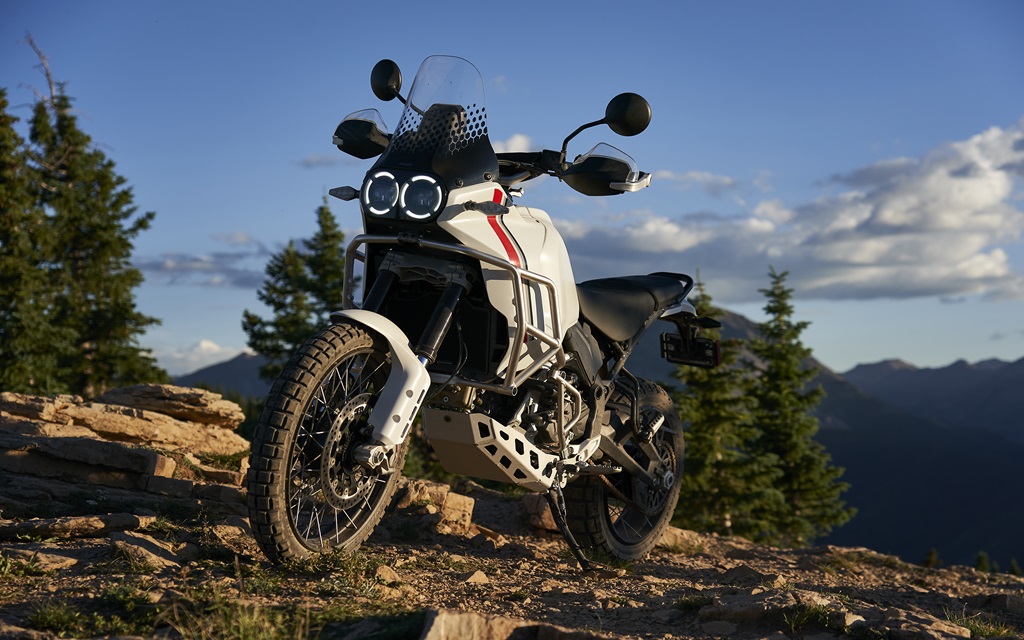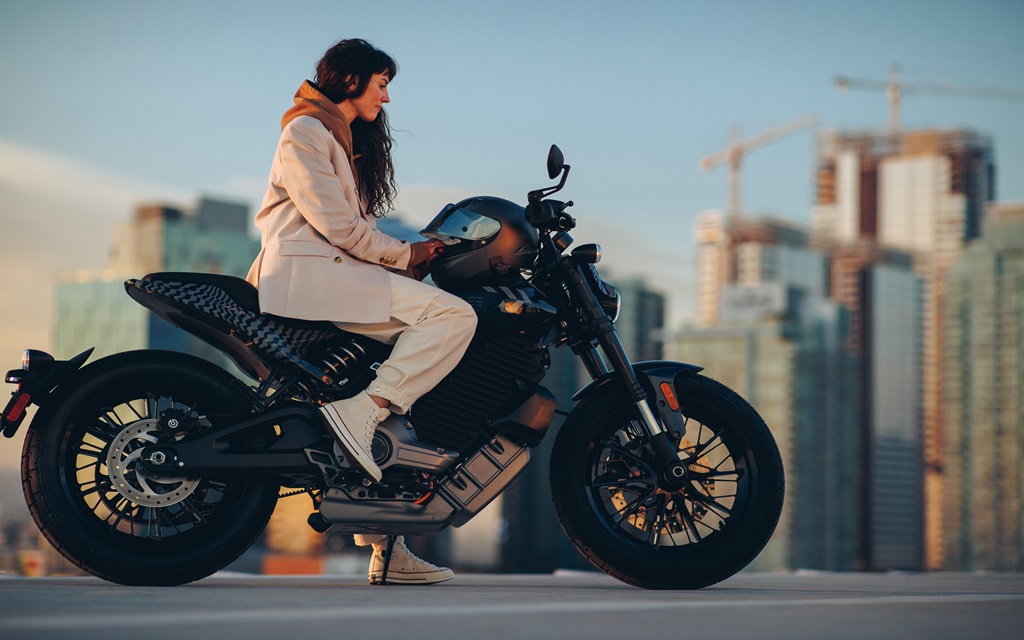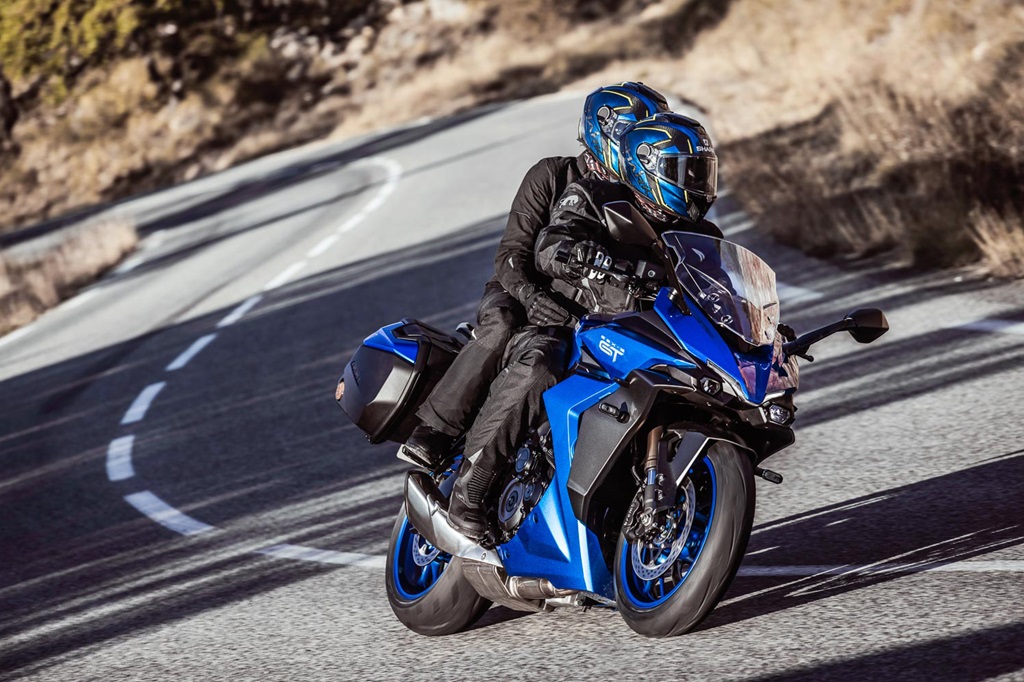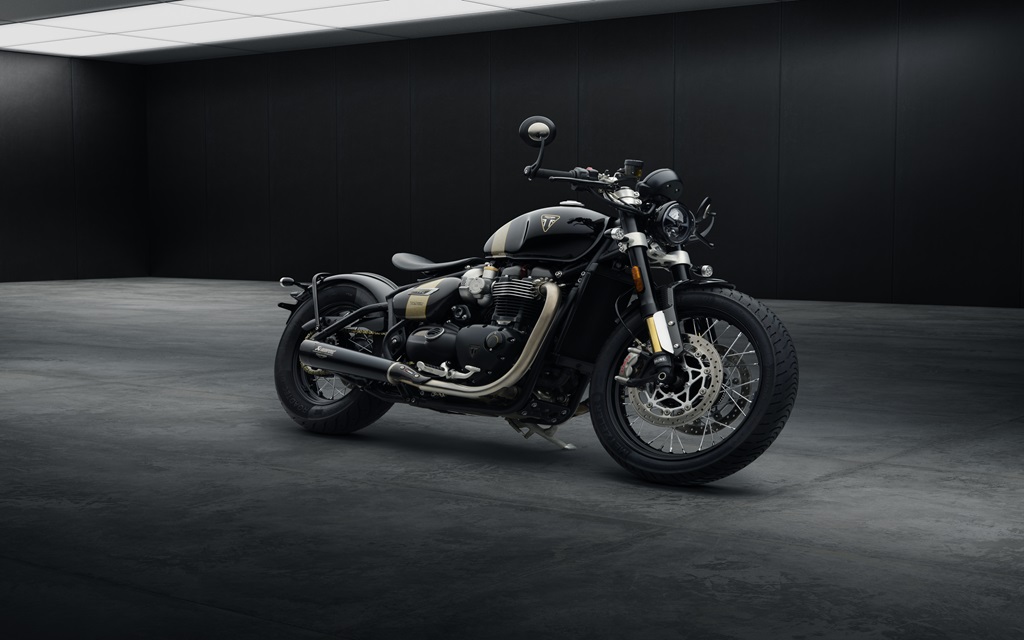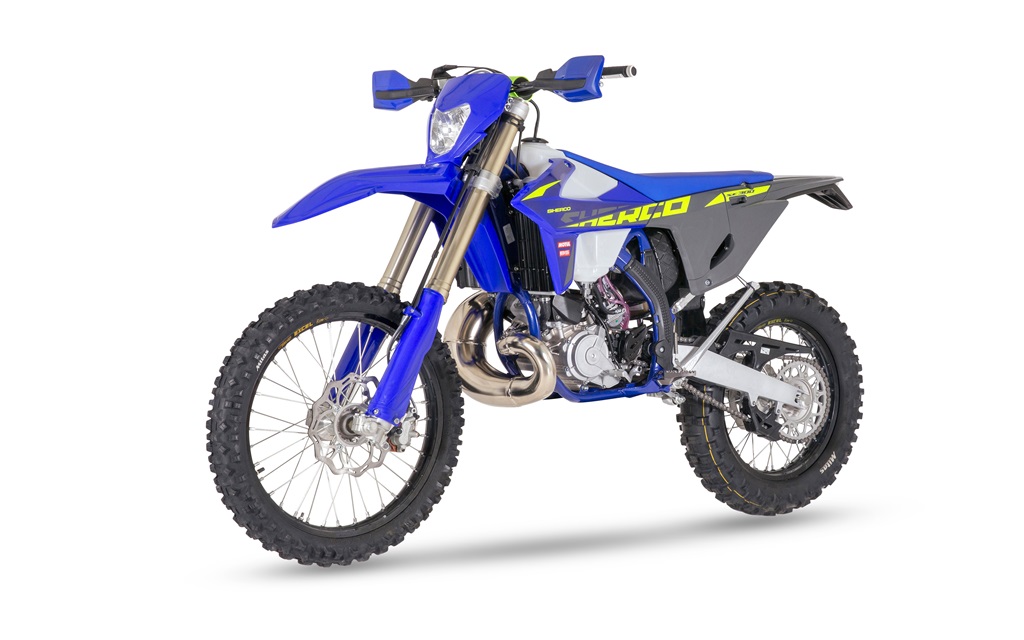On an outdoor patio of our posh Colorado Hotel, the DesertX is on display. It entered production months ago and its specs have long been released, but this is the first time I see one in the flesh. And it’s making a nice impression.
Snowmass, Colorado. It’s been a long time coming, but the much-anticipated DesertX is finally getting handed over to the specialized press today and everyone’s pretty excited. While the reasons this bike was so eagerly awaited are numerous, the uber cool «à la Cagiva Elefant» rally styling certainly ranks high on the list. There’s also the fact that Ducati hasn’t quite been humble about the X’s supposed off-road capabilities and the Italians sure aren’t changing their tune now as it’s with a clip showing the Des’ on a motocross track repeatedly being launched several meters high before smoothly landing that the pre-ride technical presentation begins. That’s putting the bar high, pun intended, since up until this point, Ducati hasn’t exactly impressed when it comes to nature-conquering ADVs : apart from its various road-biased Multistradas, the brand offers the decent heavyweight Multistrada 1260 Enduro and the Desert Sled, a cute but certainly not hard-core off-road version of the Scrambler. So, as cool as the DesertX’s promotional videos may be, a prudent dose of skepticism seems initially appropriate.
Confidence show
My biggest concern about the DesertX media launch was that after all that off-road hype, a road-biased test ride would rob us of the opportunity to verify those claims. Been there, done it and it’s not cool. Riding with the first of five media waves scheduled to test the X over a week and with a limited number of press bikes available —that had been flown in from Italy just a few days ago—, it wouldn’t have been unthinkable that to minimize the risk of damage to those precious few machines, Ducati opted for more pavement and less dirt. I shared my apprehension to Ducati North America CEO Jason Chinnock who immediately pushed back: «Oh don’t you worry. The company says it can take serious off-road stuff, we’re riding it in serious off-road stuff.» And for a day, it’s exactly what we did.
The first question ADV riders have about a new model evaluation, especially one claiming to be the proverbial real deal off-road, is always the same : in what conditions was the test conducted? It is an absolutely valid query. If most of a test is spent on pavement with only a few miles of gravel roads posing as the off-road portion, then any in depth conclusion about the model’s claimed all-terrain capabilities is essentially worthless. So, here it is: we rode the DesertX for a full day. The conditions were dry and hot with the temperature staying above 30 Celcius all day at an elevation of about 12000 ft. We didn’t encounter much sand or mud and instead mostly rode on dusty, hard-packed trails that went from moderately to very rough with the toughest sections being strongly inclined and covered with big loose rocks. Every few minutes, we encountered water bars that would launch the X in the air and slam it back down. Finally, the majority of our test day was spent off-road going up and down the hills of the area’s famous ski resorts.
All the necessary stuff, nothing superfluous
From the first glance, the DesertX looks like a credible off-road machine. On the one hand, all the right parts and specs are there: the 21 in front and 18 in back wheel combo wearing Pirelli’s excellent Scorpion Rally STRs, the tubular steel trellis frame specifically built to cope with off-road riding, the fully adjustable KYB suspension, the fork’s 230 mm and the shock’s 220 mm of generous travel, the high 250 mm ground clearance and the massive 320 mm front discs. On the other hand, several technologies and components have been voluntarily left aside, like the complex semi-active suspension popular on large ADVs or a more or less useful oversized fuel tank. This containment allows the DesertX to weigh in at 202 kg dry or 223 kg fully fueled, numbers that are almost identical to Husqvarna’s Norden 901, KTM’s 890 Adventure and Triumph’s Tiger 900 Rally Pro, the Ducati’s most direct competition. Unlike some of these machines, the $19,695 DesertX is only offered in one version, but owners can opt for accessory packages that’ll better adapt it to travel conditions or off-road use. Of note amongst the list of options is a trio of aluminum luggage, various protection bars and plates, heated handgrips, a one-piece seat, a 10 mm lower seat, a lowering kit taking the stock 875 mm seat down 30 mm to 845 mm, and even an innovative secondary fuel tank. It’s installed at the back of the bike and, when the rider chooses to and the level is low enough in the main tank, transfers its 8 liters of fuel in the latter.
Ducati had many choices to power the DesertX, from the big Multistrada 1260 Enduro V-Twin to the powerhouse V4 of the Multistrada V4 to the accessible air-cooled Scrambler V-Twin — the 1100 version of that engine was actually installed in the 2019 DesertX concept. But Ducati went for none of the above and instead chose the liquid-cooled 937 cc V-Twin of the Multistrada V2 and the latest Monster. Light and very compact, it produces 110 hp on the DesertX, barely less than on the other models it powers. Aside from a gearbox with a 14,3% shorter first gear and 8,7% shorter second gear vs the Multistrada V2, the V-Twin remains essentially identical. A comprehensive electronic rider aid suit is included and features 6 fully customizable ride modes, 3 power levels (110 hp, 95 hp, 75 hp), 4 ABS settings including OFF, 8 levels of traction control, 3 brake settings, an up and down quick shifter that can be deactivated, and cruise control. The 5-inch TFT color screen displaying all the settings and connectivity info is installed vertically, which isn’t unpleasant at all and brings somewhat of a rally flair to the cockpit. However, the amount of information is quite large and even if navigating between all the possible settings isn’t impossibly complicated, it’ll still take the rider some time and effort to get familiar with —not at all uncommon on bikes with that much electronics.
Also worthy of mention regarding the engine choice is the reduction in maintenance and cost of ownership Ducati now regularly achieves in order to make its products more accessible to the average rider. In this case, we’re talking 15,000 km between oil changes and 30,000 km between valve adjustments. The usual 2-year, unlimited mileage warranty remains.
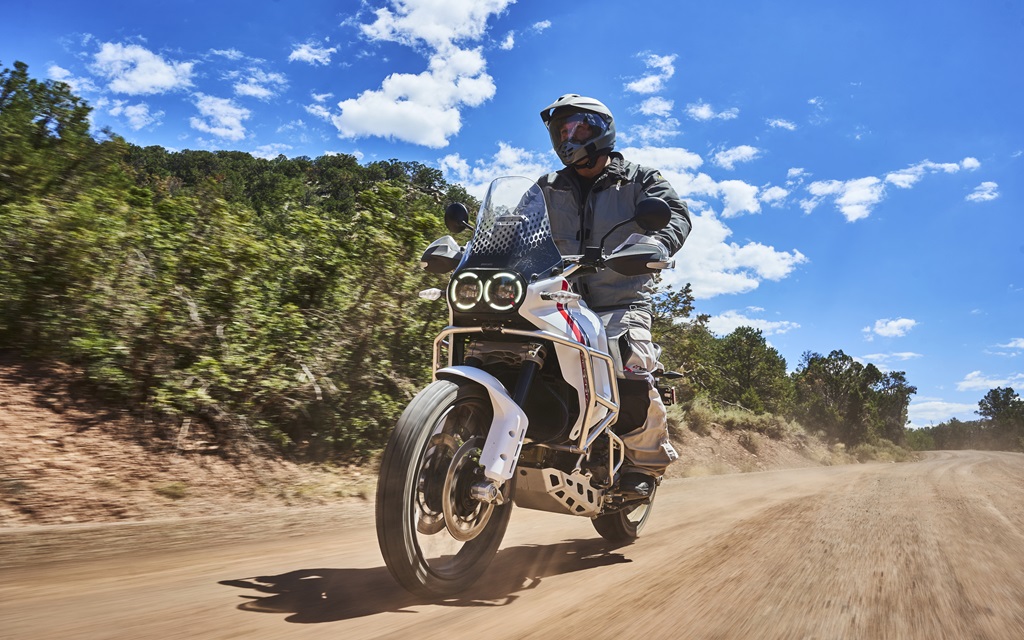
Let’s ride
With all the hype surrounding the DesertX’s off-road readiness, one could almost forget that, as an adventure model, it also belongs on the road. It’s in that environment that I first rode the bike and it immediately made a good impression. Thanks to the shorter first two gears, the V-Twin doesn’t stutter anymore at very low rpm, but rather pulls cleanly from idle while a nice, practical level of torque is pleasantly available from the first revs. Claimed max torque is 68 lb-ft at a relatively low 6500 rpm. Aside from slightly too much vibration mostly felt through the grips at high revs and an unusually disappointing quick shifter (it was harsh on some bikes and just decent on others, but never buttery; it could very well be something easily fixed with an update as it’s an electronic system, but on the launch bikes, that’s what I experienced), the X seemed perfectly at ease on the road. Thanks to handling that’s as inviting and light as it is precise and solid, to an open and balanced ADV type riding position, to good wing protection, to suspension capable of swallowing any road imperfection and to a fairly good seat, the DesertX effortlessly turns into a Swiss knife on pavement : it’s just as comfortable running errands, carving canyon roads or traveling. Long distance riders, however, will wish for a true touring seat, something Ducati could and should offer as an option. To these qualities can be added the pleasant character, nice sound and good performance of the almost one liter V-Twin. Because we rode the DesertX as such high altitude, a few ponies were definitely missing, so it’d be reasonable to expect a bit more oomph at sea level. All in all, the DesertX ended up feeling so natural and easy to ride on the road, one could theoretically ride it in that environment without ever knowing Ducati’s latest ADV possesses off-road capabilities.
But it definitely does.
Getting dirty
Interestingly, we ended up riding the DesertX in the dirt for the vast majority of our test day. The bikes were completely stock except for slightly aired-down tires (to optimize off-road traction without affecting handling too much on the road) and a few accessories, some to limit damage to the bikes (crash bars, skid plate) and others to improve comfort (heated grips that were never switched on and a very slightly more vocal slip-on). Suspension adjustments were offered, but I wanted to begin riding the bike with stock settings. They ended up being just fine.
When the road turns to dirt and the riding is best done standing up, the DesertX naturally changes its mission and morphs into a remarkably competent off-roader. Little time is needed on a trail to realize if an ADV model possesses the necessary characteristics to be pushed fairly hard off-road, or if it’s just posing as a trail-capable machine that’ll break apart as soon as conditions get tougher than gravel roads. Immediately and consistently throughout the test, the DesertX clearly demonstrated it’s built to be ridden hard. At moderate speed, on hard-packed dirt punctuated with holes and semi buried rocks, the KYB 46 mm fork and monochock nonchalantly float over everything. Increase the pace and they can be felt working more and more frenetically, but without ever feeling overwhelmed or bottoming.
While those excellent suspension components play a major role in how comfortable and easy to ride the DesertX feels off-road, so does its moderate weight. ADVs benefit immensely from lighter weight, so less mass is a constant wish on these bikes. Around 220 kg in running order is not bad at all for this category and translates into a very pleasant ease of riding. The term easy is obviously relative, since we’re still talking about a full-size motorcycle with a high seat, but the fact remains that in the dirt, the DesertX demands little effort to be steered and proves enjoyably precise when picking an exact trajectory through rocks or ruts at speed. Its weight is more of an issue in slow and tight conditions, as when going up a steep slop covered with loose rolling rocks, but even then, the anxiety felt by the rider is considerably inferior to what it’d be on a much heavier large displacement ADV. The DesertX also has the advantage of not being a hard to manage 160 hp beast and is equipped with genuinely helpful rider aids. For example, off-road, I regularly switched between Rally and Enduro modes, depending if I thought the lower power of Enduro would better deal with certain conditions, or if I felt that Rally, with its ABS deactivated at the rear, best fit other circumstances. I also really liked being able to adjust individual settings within each mode : not only did it allow me to ride the bike set up exactly to my preference, but it also made the DesertX easily transformable when I switched to another mode I set up very differently, for other conditions. Switching between modes and navigating through menus isn’t exactly as instinctive as I’d wish it to be, but to be fair, it’s a common problem that no one seems able to fully solve.
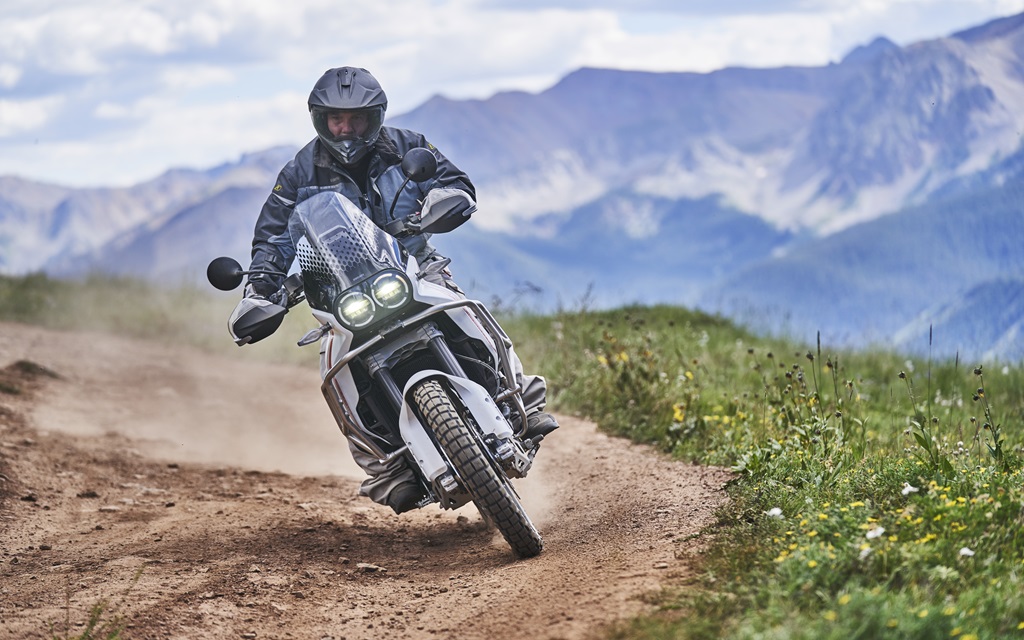
After a long day breathing Colorado dust, at dinner, CEO Jason Chinnock asked if I had fun on Ducati’s new DesertX. It was a simple and normal question, but unfortunately for him, it sparked a good ten minutes of rambling on my part before I finally answered in the affirmative and let him step away. The essence of my long answer was that, although I really do enjoy and appreciate going off-road on all these big ADVs, the reality is the experience includes a certain dose of anxiety when it comes the most 1200-1300 cc heavyweights, particularly when conditions get tighter and their mass becomes a challenge. Noting that this anxiety is reduced on lighter machines from the class below is stating the obvious, but that advantage also generally comes at the cost of less interesting engine character vs the larger displacement machines. I was realizing while answering Jason that one of the reasons I enjoyed the DesertX that much, aside from how easy to ride and competent it was off-road, was that every moment on the bike was accompanied by the pleasant character of its excellent near-liter V-Twin. While he politely and patiently nodded, I kept thinking out loud about the various aspects of the DesertX I discovered throughout the day and that finally had me conclude it was an exceptionally great machine. I’ve now had much more time to digest the experience and think things through more analytically. And yet, my original conclusion remains.
